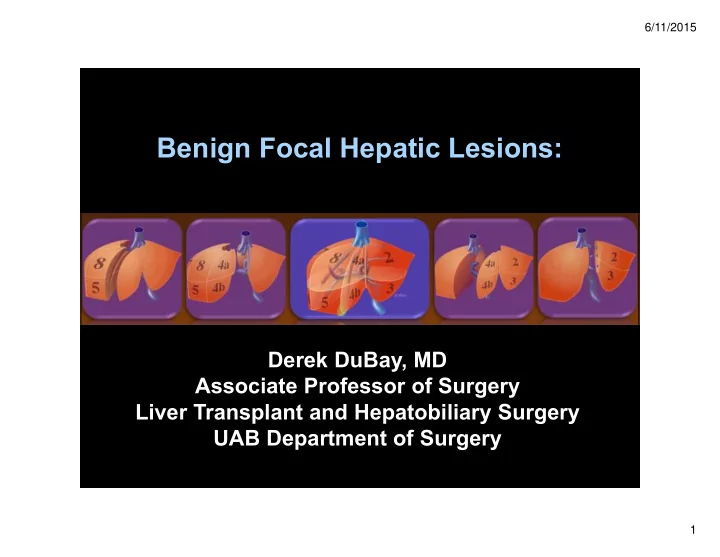

6/11/2015 Benign Focal Hepatic Lesions: Derek DuBay, MD Associate Professor of Surgery Liver Transplant and Hepatobiliary Surgery UAB Department of Surgery 1
6/11/2015 Focal Hepatic Lesions More Common 1. Hepatic Cyst 2. Hepatic Hemangiomas 3. Benign Focal Hepatic Lesions Focal Nodular Hyperplasia • Adenoma • 4. Hepatic Abscess Less Common 2
6/11/2015 Case #1 56yo BM with painless jaundice PMHx: Obesity, DM2, CRI, polycystic kidney dz Exam: Liver palpable below rt costal margin US: Polycystic liver-kidney disease, cannot readily visualize bile ducts Dominant cyst 1800 cc aspirated. Jaundice transiently resolved-recurred 3
6/11/2015 Liver Regeneration Hepatic Cysts ERCP Postop CT Postop ERCP MRI T2 MRI Venous Phase 4
6/11/2015 Hepatic Cysts Simple Cysts: 5% Incidence F>>M Polycystic Liver Disease Neoplastic Cysts Biliary Cystadenoma/ Cystadenocarcinoma Diagnosis: US, CT Scan, MRI Treatment Lap. fenestration of symptomatic simple cysts Resection of neoplastic cysts Hansman MF et al. Am J Surg 2001; 181:404 Lewis WD et al. Arch Surg 1998; 123:563 5
6/11/2015 6 Symptomatic Giant Simple Hepatic Cyst
6/11/2015 7 Symptomatic Giant Simple Hepatic Cyst
6/11/2015 Adult Polycystic Liver Disease More common in women. May or may not be associated with polycystic kidney disease. Microscopically: cysts are lined with simple biliary epithelium without communication to the biliary tract. 8
6/11/2015 Adult Polycystic Liver Disease Symptoms Usually asymptomatic. If symptomatic, symptoms are usually related to mass effect. Complications Common: infection or hemorrhage into cyst. Rare: rupture, portal hypertension, vena cava compression, conversion to malignancy, or hepatic insufficiency. 9
6/11/2015 Adult Polycystic Liver Disease Type Size Number Location Type I Large (10 cm) Few Superficial Type II Medium sized Multiple Scattered (5-7 cm) Type III Small-to-medium Multiple Scattered sized (<5 cm) 10
6/11/2015 Polycystic Liver Disease Treatment Type I and II Cystic wall resection. Some cases may require hepatic resection. Type III Partial hepatectomy if two adjacent liver segments can be spared. Some cases may require liver transplantation. 11
6/11/2015 Case #2 42yo WF with progressive RUQ fullness/ discomfort, especially when bending over PMHx: none Exam: Liver palpable below rt costal margin Labs: AFP, CEA, CA19-9 wnl Dx with 9cm cavernous hemangioma 7 years ago. Progressive increase to 16cm correlating with symptoms. 12
6/11/2015 Liver Regeneration Hepatic Hemangioma CT Arterial Phase CT Venous Phase 13
6/11/2015 Hepatic Hemangioma Liver Regeneration CT MRI 14
6/11/2015 Hepatic Hemangioma 2-7% Incidence F>>M; 1/3 multiple >5cm “ Giant Hemangioma ” Change in size common Symptoms: fullness, discomfort, early satiety Diagnosis: MRI > CT, US, tagged RBC scan Treatment Observation Enucleate Giant Symptomatic Hemangioma Pietrabissa A et al. Br J Surg 1996; 83:915 Terkivatan T et al. Br J Surg 2002; 89:1240 15
6/11/2015 Hepatic Hemangioma Kasabach-Merritt Syndrome Rare complication. Coagulopathy Intervascular coagulation, clotting, and fibrinolysis in the hemangioma. Can become systemic. 16
6/11/2015 Case #3 29yo HF Air Force complains of RUQ softball- sized mass that moves/becomes uncomfortable during physical activity. PMHx: none (not on OCP) Exam: RUQ palpable mass Labs: AFP, CEA, CA 19-9 wnl Imaging US: 12cm solid mass CT: Adenoma vs. FNH Radionucleotide study: No defect MRI: central scar 17
6/11/2015 Liver Regeneration Benign Focal Hepatic Lesions Focal Nodular Hyperplasia CT Coronal View Intraoperative View CT Arterial Phase CT Venous Phase 18
6/11/2015 Focal Nodular Hyperplasia Hyperplastic response to a congenital arterial malformation. Macroscopically: Well-circumscribed, nonencapsulated, globular and lobulated tumor. Microscopically: benign-appearing hepatocytes with fibrous septae radiating from a central scar. 19
6/11/2015 Benign Focal Hepatic Lesions Focal Nodular Hyperplasia Incidence? F>>M ?hormonal influence? Asymptomatic unless large Symptoms: fullness, discomfort, early satiety Diagnosis: MRI (EOVIST), CT Treatment Observation Embolization of symptomatic lesions Mathieu D et al. Gastro 2000; 118:560 Nagorney DM et al. World J Surg 1995; 19:13 20
Recommend
More recommend